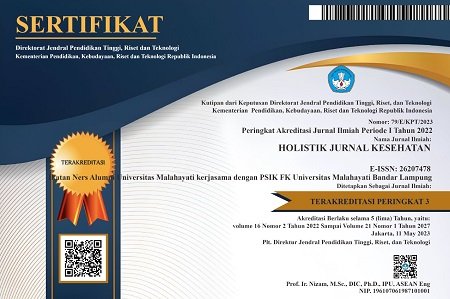Pengembangan jenjang karir perawat manajer di rumah sakit
Abstract
Becoming a Nurse Manager: A career track and system in hospital
Background: Nurse career pathway is very effective to support career development, increase retention and facilitate self actualization of nurses. Regulations on the nurse manager’s career pathway are developed in line with the clinical nurse’s professional career pathway.
Purpose: Identify and analyze needs related to the development of career path system for nurse managers
Method: A pilot project starting from data collection, problem analysis, problem priority setting, develop plan of action, implementation and evaluation. Respondents are the head nurseas many as 74 people and the nursing staff as many as 110 people. Problem analysis used fishbone diagrams.
Results: The problem that arises is the lack of optimal development of manager nurses 'career levels caused by the absence of guidelines for manager nurses' career paths, the SOP has not been compiled yet, there are nurse managers who have DIII nursing education degree, many self-assessment results of the head nurses are still feeling incompetent, nursing staff perception about the ability of the head nurse is not optimal in carrying out their roles and functions .
Conclusion: The implementation given as a solution to the problem that is making guidelines for nurse managers career pathway and writing the manuscript. The recommendation for hospitals is that guidelines are adopted so that the mechanism for career advancement can be implemented.
Keywords: A career track; Competency, Continuous professional development; Nurse manager; Hospital
Pendahuluan: Jenjang karir perawat sangat efektif menunjang perkembangan karier, meningkatkan retensi, dan memfasilitasi aktualisasi diri perawat. Regulasi tentang jenjang karir perawat manajer mulai dikembangkan sejalan dengan jenjang karir professional perawat klinis.
Tujuan: Mengidentifikasi dan menganalisis kebutuhan terkait pengembangan pola jenjang karir bagi para perawat manajer
Metode: Pilot project mulai dari pengumpulan data, analisis masalah, penetapan prioritas masalah, penyusunan plan of action, implementasi dan evaluasi. Responden adalah kepala ruangan sebanyak 74 orang dan staf perawat sebanyak 110 orang. Analisis masalah dilakukan dengan menggunakan diagram fishbone.
Hasil: Didapatkan masalah belum optimalnya pengembangan jenjang karir perawat manajer yang disebabkan belum adanya panduan pola jenjang karir perawat manajer, belum disusunnya SPO, masih ada perawat manajer yang berpendidikan DIII keperawatan, hasil self assessment kepala ruangan masih banyak yang merasa belum kompeten, staf perawat menilai kemampuan kepala ruangan belum optimal dalam menjalankan peran dan fungsinya.
Simpulan: Implementasi yang diberikan sebagai solusi permasalahan yaitu membuat panduan pola jenjang karir perawat manajer. Rekomendasi bagi rumah sakit yaitu panduan disahkan hingga mekanisme peningkatan jenjang karir dapat diimplementasikan.
Keywords
Full Text:
PDFReferences
Azwir, A. (2010). Pengembangan Pola Karir Perawat Klinik Rumah Sakit Umum Daerah Tarakan Jakarta Pusat Tahun 2008. Jurnal Manajemen Pelayanan Kesehatan, 13(01).
Bender, M., Connelly, C. D., & Brown, C. (2013). Interdisciplinary collaboration: The role of the clinical nurse leader. Journal of Nursing Management, 21(1), 165-174.
Brown, P., Fraser, K., Wong, C. A., Muise, M., & Cummings, G. (2013). Factors influencing intentions to stay and retention of nurse managers: a systematic review. Journal of Nursing Management, 21(3), 459-472.
Burket, T. L., Felmlee, M., Greider, P. J., Hippensteel, D. M., Rohrer, E. A., & Shay, M. L. (2010). Clinical ladder program evolution: Journey from novice to expert to enhancing outcomes. The Journal of Continuing Education in Nursing, 41(8), 369-374.
Cathcart, E. B., & Greenspan, M. (2013). The role of practical wisdom in nurse manager practice: why experience matters. Journal of Nursing Management, 21(7), 964-970.
Cupit, T., Stout-Aguilar, J., Cannon, L., & Norton, J. (2019). Assessing the nurse manager's span of control: A partnership between executive leadership, nurse scientists and clinicians. Nurse Leader, 17(2), 103-108.
Desai, R., & Coleman, Y. A. (2019). the effects of a clinical ladder program on professional development and job satisfaction of acute care nurses. International Journal of Nursing and Health Care Research.
Doria, H. (2015). Successful transition from staff nurse to nurse manager. Nurse Leader, 13(1), 78-81.
Eley, R., Francis, K., & Hegney, D. (2014). Nursing and the nursing workplace in Q ueensland, 2001–2010: What the nurses think. International Journal of Nursing Practice, 20(4), 366-374.
Hariyati, R. T. S., & Nurdiana, N. (2018). Retention Strategy to Minimize Nurse Turnover: A Systematic Review. International Journal of Nursing and Health Services (IJNHS), 1(2), 99-109.
Katsikitis, M., McAllister, M., Sharman, R., Raith, L., Faithfull-Byrne, A., & Priaulx, R. (2013). Continuing professional development in nursing in Australia: Current awareness, practice and future directions. Contemporary Nurse, 45(1), 33-45.
Kementerian Kesehatan Republik Indonesia. (2017). Peraturan Menteri Kesehatan Republik Indonesia Nomor 40 Tahun 2017 tentang Pengembangan Jenjang Karir Profesional Perawat Klinis. Jakarta, Indonesia. Diakses dari: http://hukor.kemkes.go.id/uploads/produk_hukum/PMK_No._40_ttg_Pengembangan_Jenjang_Karir_Profesional_Perawat_Klinis_.pdf
Krisnandi, H., Efendi, S., & Sugiono, E. (2019). Pengantar Manajemen.
Kvist, T., Mäntynen, R., Turunen, H., Partanen, P., Miettinen, M., Wolf, G. A., & Vehviläinen‐Julkunen, K. A. T. R. I. (2013). How magnetic are Finnish hospitals measured by transformational leadership and empirical quality outcomes?. Journal of Nursing Management, 21(1), 152-164.
Marquis, B. L., & Huston, C. J. (2017). Leadership roles and management functions in nursing: Theory and application. Lippincott Williams & Wilkins.
Meyer, R. M., O'brien‐Pallas, L. I. N. D. A., Doran, D., Streiner, D., Ferguson‐Paré, M. A. R. Y., & Duffield, C. (2011). Front‐line managers as boundary spanners: effects of span and time on nurse supervision satisfaction. Journal of nursing management, 19(5), 611-622.
Nurdiana, N., Hariyati, R. T. S., & Gayatri, D. (2019). Head nurse strategy for increasing nurse retention: A factor analysis. Enfermeria clinica, 29, 560-566.
Pertiwi, B., & Hariyati, R. T. S. (2019). The impacts of career ladder system for nurses in hospital. Enfermeria clinica, 29, 106-110.Pravikoff, D. (2016). Evidence-Based Care Sheet.
Puspitaningrum, I., & Hartiti, T. (2017). Peningkatan kualitas personal Dan profesional perawat melalui Pengembangan keprofesian Berkelanjutan (PKB). Deepublish.
Roche, M. A., Duffield, C. M., Homer, C., Buchan, J., & Dimitrelis, S. (2015). The rate and cost of nurse turnover in Australia. Collegian, 22(4), 353-358.
Rumah Sakit Cipto Mangunkusumo. (2019). Peraturan Direktur Utama RSUP Nasional Dr. Cipto Mangunkusumo, nomor HK.01.07/3.3/4879/2019 tentang panduan jenjang karir perawat di RSCM (2nd ed.). Jakarta: RSCM Jakarta.
Seljak, J., & Kvas, A. (2015). Three-stage data envelopment analysis as a tool for nurse leader performance appraisals: case study. SAGE Open, 5(1), 2158244015577666.
Spence Laschinger, H. K., Wong, C. A., Grau, A. L., Read, E. A., & Pineau Stam, L. M. (2012). The influence of leadership practices and empowerment on Canadian nurse manager outcomes. Journal of nursing management, 20(7), 877-888.
Spiva, L., Hart, P. L., Wesley, M. L., Gallagher, E., McVay, F., Waggoner, J., & Threatt, J. L. (2014). Psychometric testing of the clinical nurse leader staff satisfaction instrument. Journal of nursing measurement, 22(2), 302-311.
Suroso, J. (2012). Penataan sistem jenjang karir berdasar kompetensi untuk meningkatkan kepuasan kerja dan kinerja perawat di rumah sakit. Eksplanasi, 6(2).
Tsang, L. P., Sham, S. Y. A., Law, S. L. W., Szel, C. Y. S., Tang, S. K. T., Kong, C. Y., & Tarrant, M. (2017). Self-perceived performance-based training needs of senior nurse managers working in United Christian Hospital: A cross-sectional exploratory study. International Archives of Nursing and Health Car, 3(2), 1-14.
Warshawsky, N., Rayens, M. K., Stefaniak, K., & Rahman, R. (2013). The effect of nurse manager turnover on patient fall and pressure ulcer rates. Journal of Nursing Management, 21(5), 725-732.
Widiyanto, P., Hariyati, R. T. S., & Handiyani, H. (2017, February). Pengaruh Pelatihan Supervisi Terhadap Penerapan Supervisi Klinik Kepala ruang dan Peningkatan Kualitas Tindakan Perawatan Luka Di RS PKU Muhammadiyah Temanggung. In Prosiding Seminar Nasional & Internasional.
DOI: https://doi.org/10.33024/hjk.v14i2.2702
Refbacks
- There are currently no refbacks.
Copyright (c) 2020 Holistik Jurnal Kesehatan

This work is licensed under a Creative Commons Attribution-NonCommercial 4.0 International License.














